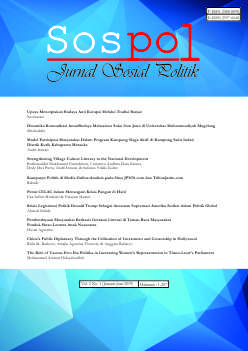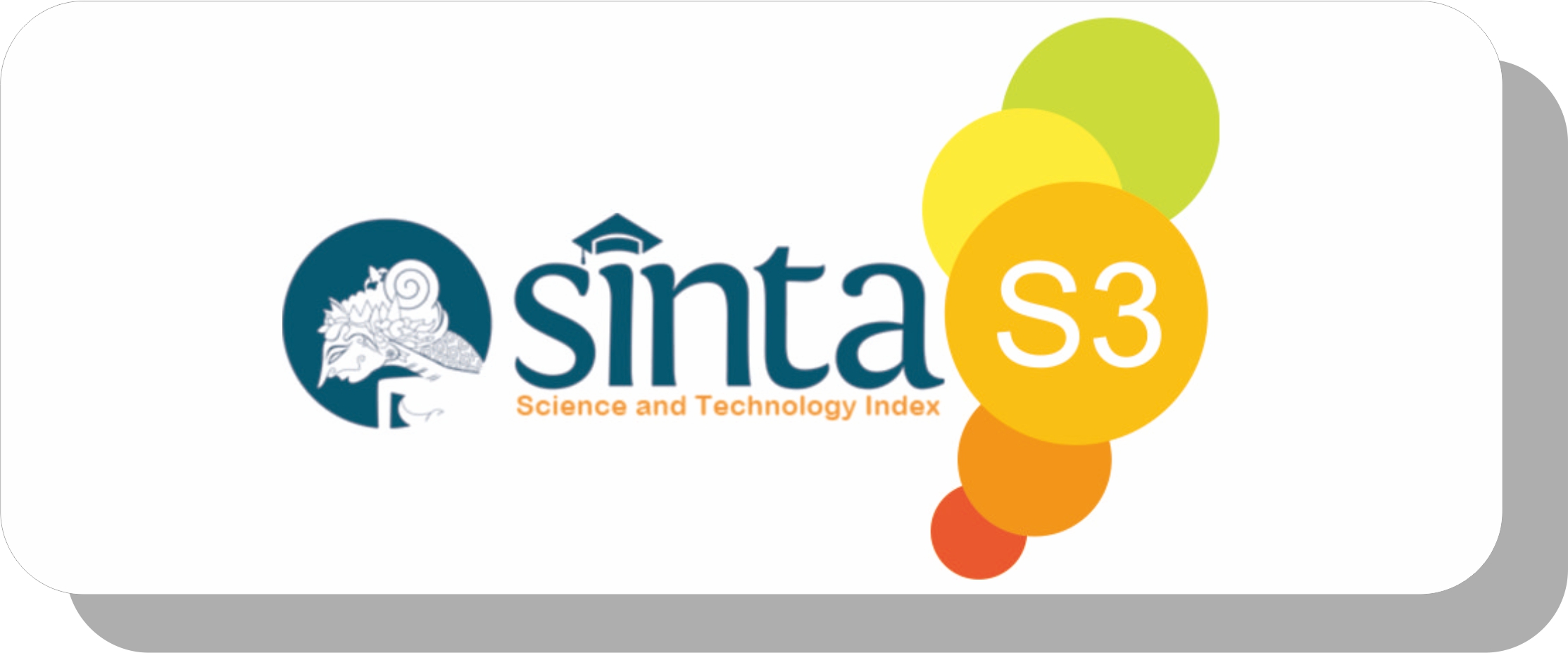Model Partisipasi Masyarakat Dalam Program Kampung Siaga Aktif di Kampung Salor Indah Distrik Kurik Kabupaten Merauke
DOI:
https://doi.org/10.22219/sospol.v5i1.6990Keywords:
Kampung Siaga Aktif Program, Maternal and Child Health, Society participationAbstract
The high rate of maternal and infant mortality shows that the quality of health services is still low, and an active alert village has been made to create a healthy lifestyle for the community. Active Alert Campaign Study in Salor Indah Village in Merauke Regency and the factors that influence it. This research uses descriptive type using qualitative. Data obtained through key informants determined purposively. The results of the study show that; (1) Salor Indah Village has fulfilled the criteria specified in the active standby village program. (2) Community participation based on the CLEAR model which contains sources of information and knowledge obtained by the community, consisting of posters and active standby village service instructions, and the community to get convenience in using active standby village facilities. Every idea taken by the community is taken as input in the leadership decision making. These ideas and thoughts were conveyed during the Village Community Consultation. (3) The inhibiting factor in the implementation of the active Alert Village program is the quality of human resources owned by Kampung Siaga not yet competent in the health sector, the community is still weak to receive information about low educational background, and also the difficulty of paying attention to the community open a healthy life.
Downloads
References
Buku
Anggraeni, L. (2009). Factors influencing participation and credit constraints of a financial self-help group in remote rural area: The case of ROSCA and ASCRA in Kemang Village West Java. Journal of Applied Sciences, 1: 1-11. http://docsdrive.com/pdfs/ansinet/jas/2009/2067-2077.pdf
Creswell, John W. (2013). Research Design: Pendekatan Kualitatif, Kuantitatif, dan Mixed. Pustaka Pelajar: Yogyakarta.
David Osborne, Ted Gaebler. (1999). Mewirausahakan Birokrasi ; Reinventing Government. Pustaka Binaman Presindo : Jakarta.
Davis, Keith. (2000). Perilaku Dalam Organisasi, Edisi ketujuh. Erlangga : Jakarta.
Denhardt, Janet V & Denhardt, Robert B. (2013). Pelayanan Publik Baru: Dari Manejemen Steering ke Serving. Kreasi Wacana: Bantul.
Denzin, Norman K & Lincoln, Yvonna S. (2009). Handbook of Qualitative Research. Pustaka Pelajar: Yogyakarta.
Huraerah, Abu. (2011). Pengorganisasian dan Pengembangan Masyarakat : Model dan Strategi Pembangunan Berbasis Kerakyatan. Humaniora : Bandung.
Karianga, Hendra. (2011). Partisipasi Masyarakat dalam Pengelolaan Keuangan Daerah (Perspektif Hukum dan Demokrasi). PT. Alumni : Bandung.
Miles, Mathew B., Huberman, A. Michael., Saldana, Johnny. (2015). Qualitative Data Analisis (A Methods Sourcebook) Third Editions. SAGE Publications, Inc.
Nasution, Zulkarnain. (2009). Solidaritas Sosial dan Partisipasi Masyarakat Desa Transisi (Suatu Tinjauan Sosiologis). UMM Press : Malang.
Pratchett, Lawrence. Gerry, Stocker. Vivien, Lowndes. (2009). Empowering communities to influence local decision making (A systematic review of the evidence). University Southampton : United Kingdom.
Ross. Murray G., and B. W. Lappin. (1967). “Community Organization: theory, principles and practice”. Second Edition: New York: Harper & Row Publishers.
Soetomo. (2008). Strategi-Strategi Pembangunan Masyarakat. Pustaka Pelajar : Yogyakarta.
Jurnal
Faturahman, B. M. (2018). Aktualisasi Nilai Demokrasi dalam Perekrutan dan Penjaringan Perangkat Desa. Sospol, 4(1), 132–148.
Sulaeman, Endang Sutisna. (2012). Model Pemberdayaan Masyarakat Bidang Kesehatan. Model Pemberdayaan Masyarakat Bidang Kesehatan, Studi Program Desa Siaga. Kesmas, Jurnal Kesehatan Masyarakat Nasional Vol. 7, No. 4, November 2012. Hal. 186-192.Handayani, S. 2006. Pelibatan Masyarakat Marjinal dalam Perencanaan dan Penganggaran Partisipatif. KOMPIP : Solo.
Callahan, Kathe. (2007). Citizen Participation: Models and Methods. International Journal of Public Administration. Volume 30. Issue 11: Government Performance. Pages 1179-1196. . https://doi.org/10.1080/01900690701225366
Kementrian Kesehatan Republik Indonesia. (2010). Tentang Pedoman Umum Pengembangan Desa dan Kelurahan Siaga Aktif. http://pusatkrisis.kemkes.go.id/__pub/files54175Pedoman_Pengembangan_Desa_dan_Kelurahan_Siaga_Aktif.pdf
Kementrian Kesehatan Republik Indonesia. (2013). Tentang Pedoman Pelaksanaan dan Pembinaan Pemberdayaan Masyarakat Bidang Kesehatan. https://peraturan.bkpm.go.id/jdih/userfiles/batang/PMK%20No.%2065%20ttg%20Pemberdayaan%20Masyarakat%20Bidang%20Kesehatan.pdf
Krisnovianti. (2015). Evaluasi Program Desa Siaga Aktif Di Desa Kaliamok Kecamatan Malinau Utara Kabupaten Malinau. Jurnal Pemerintahan Integratif. Volume 3 Nomor 1. Hal : 263 -274
Lowndes, V., Pratchett, L. and Stoker, G. (2006). 'Diagnosing and remedying the failings of official participation schemes: the CLEAR framework' Social Policy and Society, Vol 5, No 2 pp 281-291;
Laksana, Nuring Septyasa. (2013). “Bentuk-Bentuk Partisipasi Masyarakat Desa dalam Progam Desa Siaga Di Desa Bandung Kecamatan Playen Kabupaten Gunung Kidul Provinsi Daerah Istimewa Yogyakarta”. Jurnal Kebijakan dan Manajemen Publik. Volume 1, Nomor 1, Januari 2013. ISSN 2303 – 341X.
Praneetha.B.S., (2013). “People’s Participation and Environmental Protection”. Journal of Business Management & Social Sciences Research (JBM&SSR). Volume 2, No.2, February 2013. ISSN No: 2319‐5614
Quick, Narvaez, and Saunoi-Sandgren. (2014). Participants’ Criteria For Evaluating Public Participation In Transportation Policy-Making: A Paper Submitted July 27, 2014 for Presentation only at the 2015 Annual Meeting of the Transportation Research Board. https://www.researchgate.net/publication/272178392
Mikkelsen, Rolf. (2003). Conditions for high democratic awareness and participation in Norwegian schools. JSSE – Journal of Social Science Education. DOI: 10.4119/UNIBI/jsse-v2-i1-465
Downloads
Published
How to Cite
Issue
Section
License
Authors who publish with this journal agree to the following terms:
- Authors retain copyright and grant the journal right of first publication with the work simultaneously licensed under a Creative Commons Attribution-ShareAlike 4.0 International License that allows others to share the work with an acknowledgement of the work's authorship and initial publication in this journal.
- Authors are able to enter into separate, additional contractual arrangements for the non-exclusive distribution of the journal's published version of the work (e.g., post it to an institutional repository or publish it in a book), with an acknowledgement of its initial publication in this journal.
- Authors are permitted and encouraged to post their work online (e.g., in institutional repositories or on their website) prior to and during the submission process, as it can lead to productive exchanges, as well as earlier and greater citation of published work (See The Effect of Open Access).

This work is licensed under a Creative Commons Attribution-ShareAlike 4.0 International License.



















